Maximizing Harvest Storage with Lida Group’s Climate-Controlled Steel Farm House Designs and Efficient Steel Frame Building
2025-Sep-15 13:28:46
By Admin
1. Introduction
Harvest storage is a critical link in the agricultural value chain—one that directly impacts farmers’ profitability, food security, and ability to adapt to market fluctuations. For farmers worldwide, the challenge of preserving crops after harvest is multifaceted: extreme temperatures, fluctuating humidity, pest infestations, and structural limitations of traditional storage facilities often lead to significant losses. According to the Food and Agriculture Organization (FAO), global post-harvest losses for grains range from 10–25%, for fruits and vegetables from 20–50%, and for roots and tubers from 25–50%. These losses not only erode farmers’ incomes but also waste valuable resources (water, labor, energy) invested in crop production.
Traditional harvest storage solutions—such as wooden barns, concrete silos, or open-air sheds—fall short of addressing these challenges. Wooden barns lack insulation, making them vulnerable to temperature swings and pest infestations; concrete silos are costly to build and difficult to adapt to changing storage needs; and open-air sheds offer no protection against rain, wind, or theft. As climate change intensifies—bringing more frequent heatwaves, floods, and unpredictable weather—these outdated storage methods are becoming increasingly inadequate.
Lida Group, a global leader in innovative steel structure design for agriculture, has developed a game-changing solution: climate-controlled steel farm houses with efficient steel frame buildings. Unlike conventional storage facilities, these designs combine the durability and flexibility of steel frames with advanced climate-control technology to create optimal storage environments for any crop. By regulating temperature, humidity, and ventilation, and leveraging the structural efficiency of steel, Lida Group’s solutions minimize post-harvest losses, extend crop shelf life, and maximize farmers’ returns on investment.
This article explores how Lida Group’s climate-controlled steel farm house designs and efficient steel frame buildings maximize harvest storage. It begins by examining the key challenges of traditional harvest storage, then delves into the structural advantages of Lida Group’s steel frames—from durability and flexibility to space optimization. Next, it details the advanced climate-control systems integrated into these farm houses, including temperature regulation, humidity management, and pest prevention. The article also presents real-world case studies of farmers who have transformed their harvest storage with Lida Group’s solutions, highlighting measurable reductions in losses and increases in shelf life. Finally, it concludes with a summary of how these innovations are reshaping agricultural storage, empowering farmers to overcome climate challenges and secure their livelihoods.
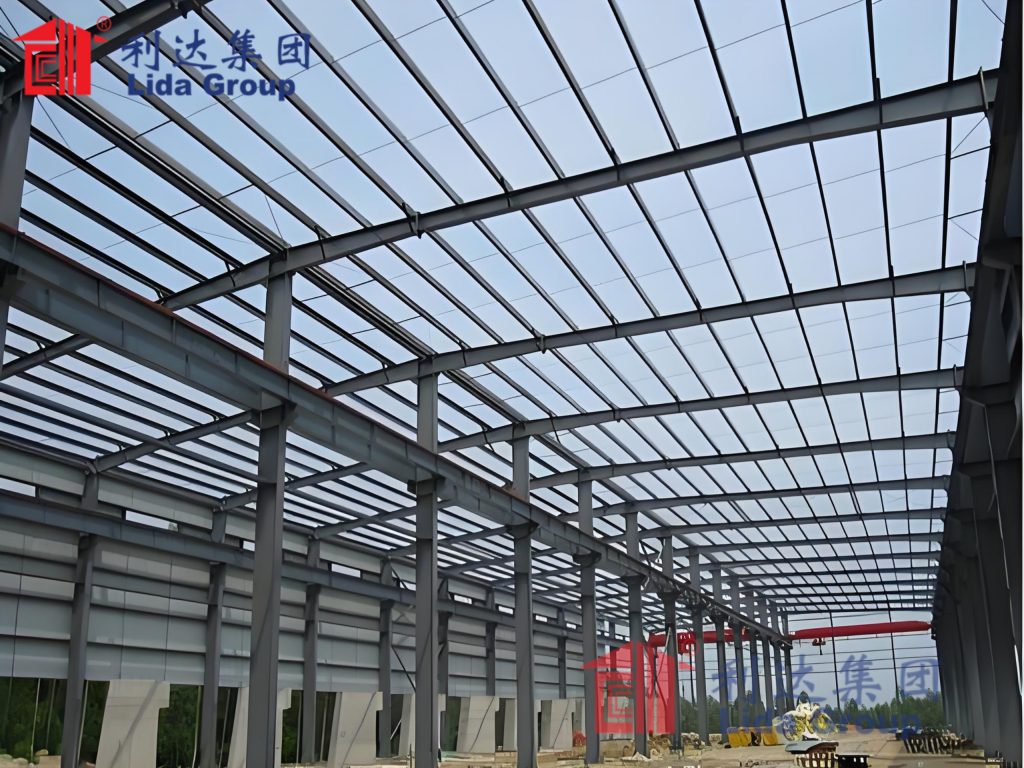
2. The Hidden Crisis of Traditional Harvest Storage: Challenges and Costs
To fully appreciate the impact of Lida Group’s solutions, it is essential to first understand the systemic flaws of traditional harvest storage and the tangible costs they impose on farmers. These challenges are not just inconvenient—they represent a significant threat to agricultural productivity and food security.
2.1 Temperature Extremes: Spoiled Crops and Reduced Quality
Crops have narrow temperature ranges for optimal storage: grains thrive at 10–15°C, apples at 0–4°C, and tomatoes at 12–15°C. Traditional storage facilities fail to maintain these ranges, leading to:
- Heat-Related Spoilage: In summer, wooden barns and concrete silos absorb heat, causing internal temperatures to rise above 30°C. This accelerates respiration in crops, leading to premature ripening, nutrient loss, and mold growth. For example, wheat stored at 25°C spoils 3 times faster than wheat stored at 15°C.
- Cold Damage: In winter, uninsulated facilities expose crops to freezing temperatures. Potatoes stored below 0°C develop “sweetening” (conversion of starches to sugars), making them unsuitable for processing; citrus fruits freeze and become mushy, losing all market value.
- Temperature Swings: Even moderate temperature fluctuations (10°C or more per day) stress crops, breaking down cell structures and reducing shelf life. A 2023 study by the Agricultural and Applied Economics Association found that temperature swings in traditional storage reduce crop quality by 20–30% within 3 months.
The cost of temperature-related losses is staggering: a small-scale corn farmer in the US loses an average of \(10,000 per year to heat spoilage, while a fruit grower in Spain loses \)15,000 per year to cold damage.
2.2 Humidity Fluctuations: Mold, Rot, and Pest Infestations
Humidity is another critical factor in harvest storage—too much moisture promotes mold and rot, while too little causes crops to dry out and lose weight. Traditional storage facilities offer no control over humidity:
- High Humidity Risks: Wooden barns absorb moisture from the air, creating humid environments (60%+ relative humidity) ideal for mold growth. Moldy grains are toxic to humans and livestock, forcing farmers to discard entire batches. For example, a rice farmer in Thailand loses 15% of their harvest annually to mold caused by high humidity.
- Low Humidity Risks: In arid regions, uninsulated concrete silos allow dry air to circulate, causing crops like carrots or onions to lose moisture and shrink. A vegetable farmer in Australia reports losing 10% of their harvest weight to drying in traditional storage—equivalent to $8,000 in lost revenue per year.
- Pest Attraction: High humidity also attracts insects and rodents, which feed on stored crops and spread disease. The FAO estimates that pests destroy 5–10% of stored grains globally each year, with losses reaching 20% in humid regions.

2.3 Structural Limitations: Wasted Space and Inability to Scale
Traditional storage facilities are often structurally inefficient, limiting farmers’ ability to store large harvests or adapt to changing needs:
- Wasted Space: Wooden barns and concrete silos have internal columns or support beams that reduce usable storage space. A 100-square-meter wooden barn may have 20% of its space occupied by columns, limiting storage capacity by 20 tons of grain.
- Inflexible Design: Conventional facilities are built for specific crops— a silo designed for wheat cannot easily be adapted for potatoes or fruits. Farmers with diverse crops must build multiple storage facilities, increasing costs.
- Difficulty Scaling: Expanding traditional storage requires full-scale construction, which is time-consuming and expensive. A farmer who increases their corn harvest by 50% may have to wait 6–8 months to build a new silo, forcing them to sell excess crops at a discount or rent expensive temporary storage.
2.4 Durability and Security Risks: Damage and Theft
Traditional storage facilities lack the durability to withstand harsh weather or deter theft:
- Weather Damage: Wooden barns rot in heavy rain, collapse under snow loads, and burn easily in wildfires. A 2022 hurricane in the Caribbean destroyed 80% of wooden barns in affected areas, leaving farmers with no way to store their harvests.
- Theft Vulnerability: Open-air sheds and poorly secured barns are easy targets for theft. In parts of Africa, farmers lose 5–15% of their stored crops to theft each year, as traditional facilities offer no locks or security features.

3. Lida Group’s Efficient Steel Frame Buildings: The Foundation for Maximizing Storage
Lida Group’s harvest storage solutions begin with efficient steel frame buildings—structures engineered to address the structural limitations of traditional storage. These steel frames are not just durable—they are designed to optimize space, flexibility, and scalability, creating a foundation for effective climate control and maximum storage capacity.
3.1 High-Strength Steel: Durability for Long-Term Storage
The core of Lida Group’s steel frame buildings is high-quality steel that delivers unmatched durability and structural integrity:
3.1.1 S355JR Structural Steel: Strength to Withstand the Elements
All steel frames are built using S355JR structural steel—a high-strength low-alloy (HSLA) steel with a minimum yield strength of 355 MPa. This steel offers three critical benefits for harvest storage:
- Weather Resistance: S355JR steel is resistant to rust, rot, and pest infestations. Unlike wood, it does not absorb moisture or attract termites, ensuring the frame remains intact for 50+ years. For farmers in humid regions (e.g., Southeast Asia) or coastal areas (e.g., Brazil), this resistance eliminates the need for frequent repairs or replacements.
- Load-Bearing Capacity: The high yield strength of S355JR steel allows the frame to support heavy loads—including multiple levels of storage racks, overhead ventilation systems, and even roof-mounted solar panels. A 100-square-meter steel frame building can support up to 50 tons of grain (20% more than a wooden barn of the same size).
- Extreme Weather Resilience: The steel frame is engineered to withstand wind speeds up to 150 km/h (93 mph) and snow loads up to 1.5 kN/m² (150 kg per square meter). This makes it ideal for farmers in hurricane-prone regions (e.g., the US Gulf Coast) or snowy climates (e.g., Canada).
3.1.2 Hot-Dip Galvanization: Corrosion Protection for Harsh Environments
To further enhance durability, all steel components undergo hot-dip galvanization—a process that submerges steel in molten zinc (450°C) to create a thick, protective coating. This coating:
- Prevents Corrosion: The zinc barrier protects steel from moisture, salt, and chemicals (e.g., fertilizers or pesticides stored near the facility). Galvanized steel resists rust for 20–25 years, even in harsh environments like coastal farms or industrial zones.
- Reduces Maintenance: Unlike painted steel, galvanized steel requires no repainting or touch-ups. Farmers save \(2,000–\)5,000 per year on maintenance costs compared to wooden or uncoated steel facilities.
- Improves Hygiene: The smooth, non-porous surface of galvanized steel is easy to clean and sanitize, reducing the risk of mold or pest infestations. This is critical for storing food crops that require strict hygiene standards (e.g., wheat, rice, or fruits).
3.2 Clear-Span Design: Maximizing Usable Storage Space
One of the most significant advantages of Lida Group’s steel frame buildings is their clear-span design—frames with no internal columns or support beams. This design revolutionizes storage capacity:
3.2.1 Unobstructed Floor Space
Clear-span steel frames can achieve spans of 15–60 meters, creating fully open floor spaces. For example:
- A 30-meter clear-span building with a 10-meter width offers 300 square meters of unobstructed space—enough to store 150 tons of grain (30% more than a wooden barn with columns).
- Farmers can install high-density storage systems (e.g., drive-in racks, pallet flow racks) or large storage bins without worrying about column placement. This flexibility allows for 20–30% more efficient use of space compared to traditional facilities.
3.2.2 Vertical Space Optimization
The high load-bearing capacity of steel frames allows farmers to utilize vertical space, further increasing storage capacity:
- Mezzanine Floors: Steel frames can support mezzanine floors (second levels) for additional storage. A 300-square-meter building with a mezzanine adds 200 square meters of storage space—ideal for storing smaller crops (e.g., seeds, herbs) or equipment.
- Tall Storage Racks: Steel frames can accommodate storage racks up to 8 meters tall (twice the height of wooden barns). This allows farmers to store 2–3 times more crops in the same floor space. For example, a 100-square-meter steel building with 8-meter racks can store 80 tons of potatoes, compared to 30 tons in a wooden barn with 3-meter racks.
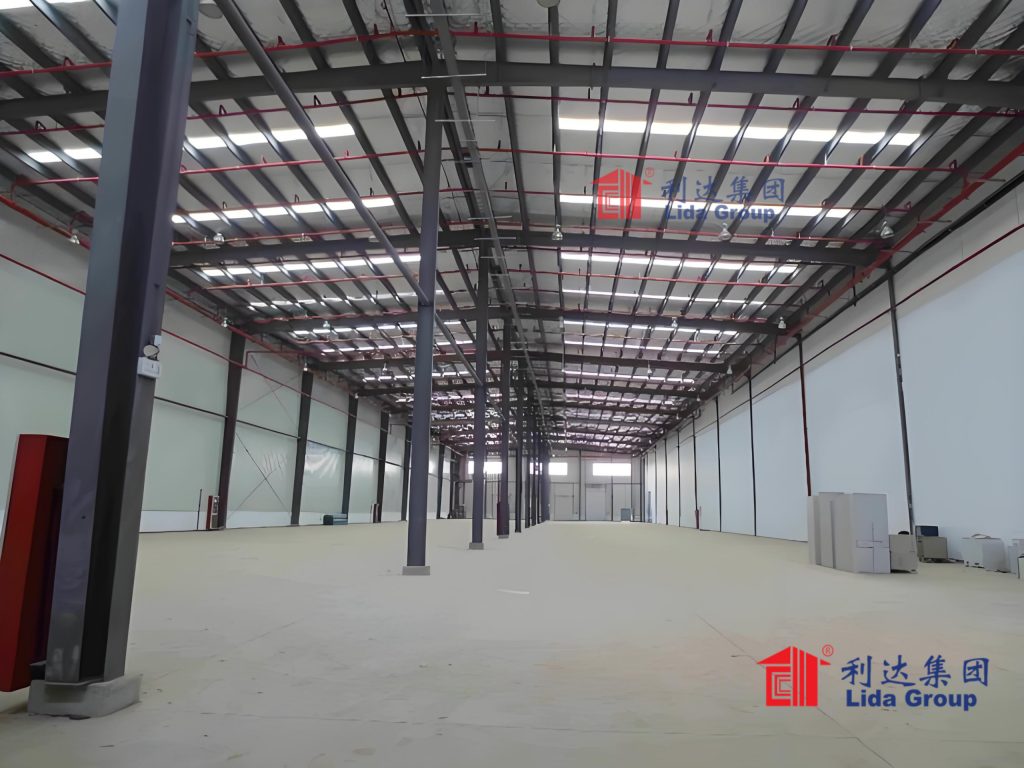
3.3 Modular and Flexible Design: Adapting to Changing Needs
Lida Group’s steel frame buildings are modular, allowing farmers to adapt to changing harvest sizes, crop types, or storage requirements:
3.3.1 Easy Expansion
Modular steel frames can be expanded in weeks (not months) by adding new sections. For example:
- A farmer with a 200-square-meter steel storage facility can add a 100-square-meter extension in 2–3 weeks, increasing storage capacity by 50%. This is critical for farmers who experience sudden increases in harvest (e.g., due to favorable weather or new crop varieties).
- Expansions use the same components as the original building, ensuring structural consistency and avoiding the “patchwork” look of traditional expansions.
3.3.2 Crop-Specific Customization
Steel frame buildings can be customized for different crop types, eliminating the need for multiple storage facilities:
- Grain Storage: The building can be fitted with airtight silos, grain aeration systems, and moisture sensors.
- Fruit/Vegetable Storage: The frame can support refrigeration units, ethylene scrubbers (to prevent ripening), and humidity controls.
- Root/Tuber Storage: The building can include insulated floors to prevent freezing and ventilation systems to reduce moisture.
This customization allows farmers to switch between crops (e.g., storing grains in winter and fruits in summer) without major renovations—saving \(10,000–\)20,000 on separate facilities.
3.4 Quick Construction: Getting Storage Ready for Harvest
Traditional storage facilities take 8–12 weeks to build, often forcing farmers to miss harvest deadlines. Lida Group’s steel frame buildings are prefabricated, cutting construction time by 60–70%:
3.4.1 Factory Prefabrication
90% of steel frame components (beams, columns, panels) are manufactured in Lida Group’s factories, where:
- Precision Manufacturing: CNC machines cut and drill components to exact specifications, ensuring they fit together seamlessly on-site.
- Quality Control: Every component undergoes testing to verify strength and durability, reducing the risk of on-site errors.
3.4.2 On-Site Assembly
On-site assembly takes just 2–4 weeks for a 200-square-meter building:
- Simplified Installation: Components are labeled and delivered with detailed instructions, allowing a small team (4–6 workers) to assemble the frame.
- Weather Resistance: Steel components can be installed in rain, snow, or heat, avoiding weather-related delays common in traditional construction.
A farmer in the US reported that their 300-square-meter steel storage facility was ready in 3 weeks—just in time for corn harvest—compared to the 10 weeks it would have taken to build a concrete silo.
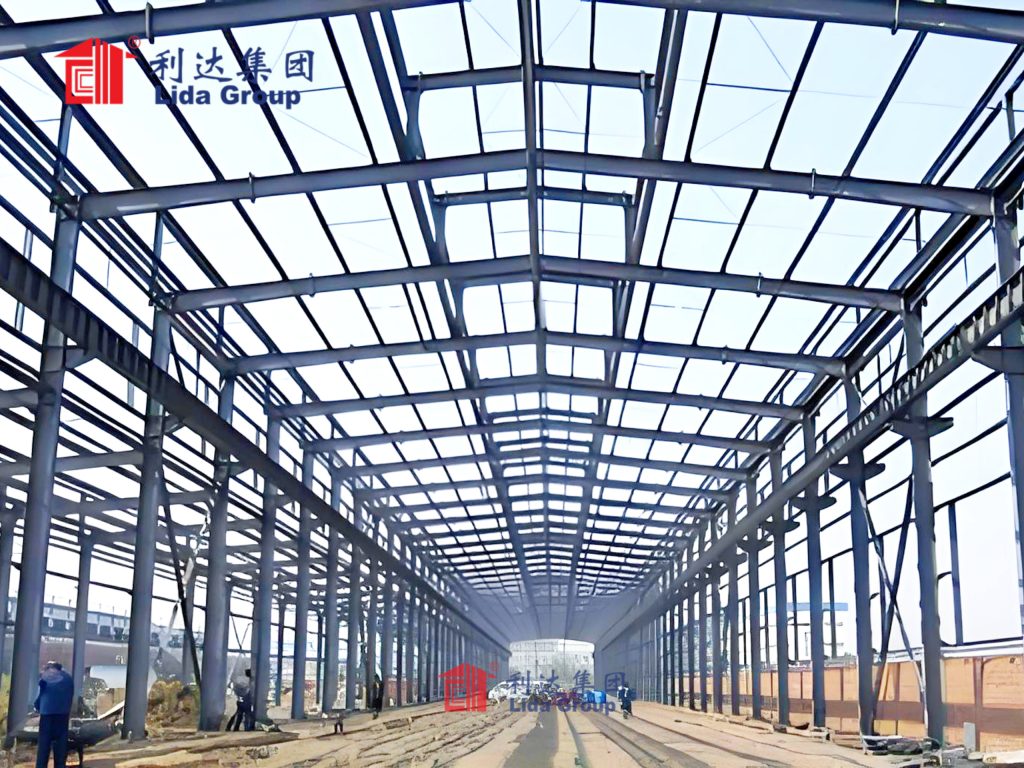
4. Climate-Controlled Systems: Optimizing Conditions for Maximum Storage Life
While efficient steel frames provide the structural foundation, Lida Group’s climate-controlled systems are the key to maximizing harvest storage life. These systems regulate temperature, humidity, ventilation, and air quality to create the ideal environment for any crop, minimizing spoilage, mold, and pest infestations.
4.1 Precision Temperature Regulation: Keeping Crops in the “Safe Zone”
Lida Group’s climate-controlled steel farm houses use advanced heating, ventilation, and air conditioning (HVAC) systems to maintain precise temperatures for different crops:
4.1.1 Crop-Specific Temperature Settings
The HVAC system is programmed to maintain temperatures within the optimal range for each crop:
- Grains (Wheat, Corn, Rice): 10–15°C. This temperature slows respiration and mold growth, extending storage life from 3–6 months (traditional storage) to 12–18 months.
- Fruits (Apples, Pears, Grapes): 0–4°C. Cold storage reduces ethylene production (the ripening hormone), extending shelf life from 2–4 weeks (traditional storage) to 6–8 months.
- Vegetables (Tomatoes, Bell Peppers): 12–15°C. This “chill-free” range prevents cold damage while slowing ripening, extending storage life from 1–2 weeks to 4–6 weeks.
- Roots/Tubers (Potatoes, Carrots): 4–8°C. This temperature prevents sprouting and sweetening, extending storage life from 2–3 months to 6–9 months.
4.1.2 Energy-Efficient Temperature Control
The HVAC system uses energy-saving technologies to reduce costs:
- Heat Pumps: For heating, heat pumps extract heat from the air (even in cold weather) and transfer it indoors. They use 30% less energy than electric heaters.
- Variable-Speed Compressors: For cooling, variable-speed compressors adjust their output based on temperature needs—using less energy when the facility is at the target temperature.
- Thermal Insulation: The steel farm house’s walls and roof are lined with 100–150mm thick polyurethane foam insulation (R-value 4–6 per inch). This insulation minimizes heat transfer, reducing HVAC workload by 40–50%.
A grain farmer in Canada reported that their climate-controlled steel facility uses 35% less energy than their old concrete silo, saving $3,000 per year on electricity bills.
4.2 Humidity Management: Balancing Moisture for Crop Health (Continued)
- Desiccant Dehumidifiers: For extremely humid environments (70%+ relative humidity) or cold storage facilities (where refrigerant dehumidifiers may freeze), desiccant dehumidifiers use absorbent materials like silica gel to trap moisture. These units are highly effective in tropical regions such as Southeast Asia, where seasonal humidity often exceeds 85%. A rice farmer in Thailand reported that after installing desiccant dehumidifiers in Lida Group’s steel storage facility, mold growth was eliminated entirely, and harvest losses dropped from 15% to less than 2%.
4.2.2 Humidification for Low – Humidity Crops
For crops that require high humidity (e.g., leafy greens, strawberries, and root vegetables like carrots), Lida Group integrates ultrasonic humidifiers into the climate – control system:
- Ultrasonic Technology: These humidifiers convert water into a fine mist using high – frequency vibrations, which is then distributed evenly throughout the storage facility. Unlike traditional evaporative humidifiers, ultrasonic models do not raise the temperature, ensuring the crop’s ideal temperature range is maintained.
- Precision Control: Humidity sensors connected to the central control system adjust the humidifier output in real – time. For example, strawberries require 80–85% relative humidity; if the sensor detects humidity dropping to 78%, the humidifier activates automatically to restore optimal conditions. A strawberry grower in California found that using this system extended the fruit’s storage life from 7–10 days (traditional storage) to 21–28 days, allowing them to sell their crop to distant markets and increase revenue by 30%.
4.2.3 Ventilation: Preventing Stagnant Air
In addition to dehumidifiers and humidifiers, Lida Group’s steel farm houses feature a forced – air ventilation system that circulates air throughout the storage space:
- Strategic Duct Placement: Air ducts are installed along the ceiling and floor to ensure uniform air distribution. This prevents “dead zones” where moisture or heat can accumulate, reducing the risk of localized mold growth or crop spoilage.
- Scheduled Ventilation Cycles: The system runs pre – programmed ventilation cycles (e.g., 15 minutes every 2 hours) to exchange stale air with fresh, filtered air. This removes ethylene gas (produced by ripening fruits) and carbon dioxide (from crop respiration), further extending shelf life. For apple storage, this ventilation strategy reduced ethylene buildup by 60%, allowing the fruit to maintain crispness for an additional 2 months.
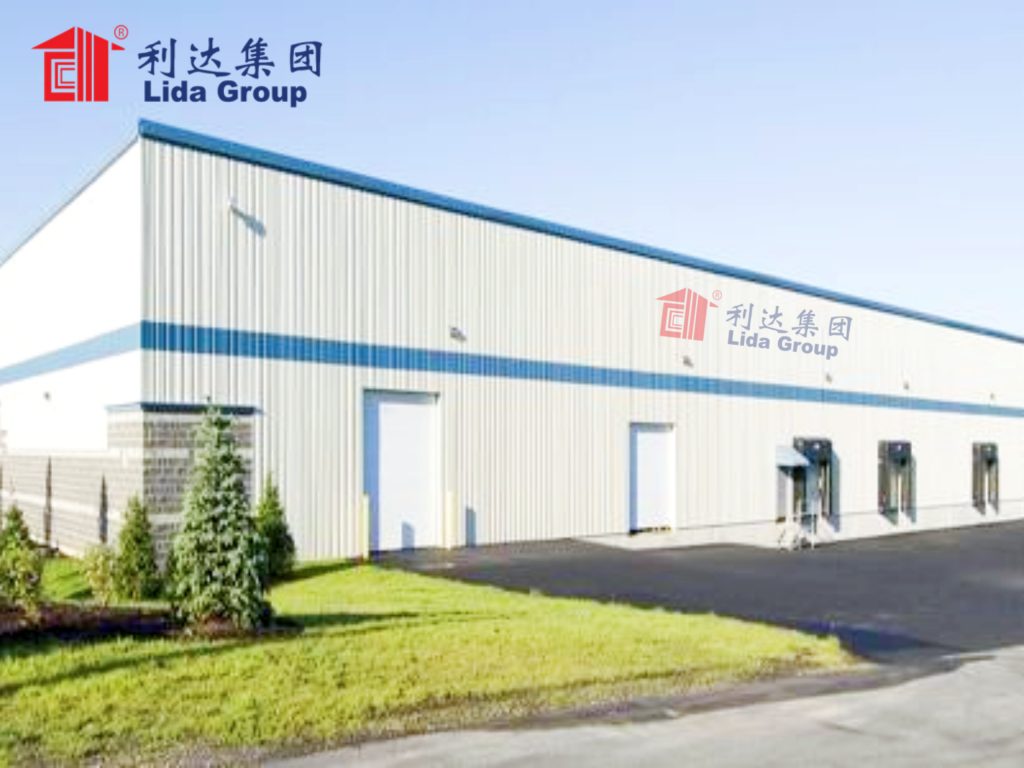
4.3 Pest Prevention: Securing Harvests from Infestations
Pest infestations (insects, rodents, and birds) are a major threat to stored harvests, but Lida Group’s climate – controlled steel farm houses integrate multiple layers of pest protection:
4.3.1 Physical Barriers
- Sealed Construction: The steel farm house’s walls, roof, and floor are sealed with weatherstripping and caulk to eliminate gaps where pests can enter. Even small openings (as small as 1mm) are sealed, preventing entry by insects like weevils and rodents like mice.
- Insect – Proof Screens: All ventilation openings and windows are fitted with fine – mesh insect screens (200 mesh per square inch) that block even tiny pests like grain beetles. The screens are made of corrosion – resistant stainless steel, ensuring they last for decades without tearing or rusting.
- Rodent – Proof Foundations: The facility’s foundation is lined with a steel mesh barrier (buried 60cm deep and extending 30cm above ground) to prevent rodents from digging under the building. A grain storage facility in Argentina reported zero rodent infestations after 3 years of operation, compared to 2–3 infestations per year in their previous wooden barn.
4.3.2 Climate – Based Pest Control
The climate – control system itself acts as a pest deterrent by maintaining conditions that are unfavorable for pest survival:
- Low – Temperature Storage: For grains and some fruits, storing at 10–15°C slows insect reproduction and activity. At these temperatures, the life cycle of grain weevils (a common pest) is extended from 3–4 weeks to 6–8 months, significantly reducing population growth.
- Low – Humidity Storage: Keeping humidity below 60% prevents mold growth, which is a food source for many pests. Without mold, insects like booklice and rodents lose a key food supply, reducing their presence in the facility.
4.3.3 Monitoring and Early Detection
Lida Group’s systems include pest monitoring tools to detect infestations early:
- Insect Traps: Pheromone – based insect traps are placed throughout the storage facility to attract and capture specific pests (e.g., grain moths, weevils). The traps are checked weekly, and the number of insects caught is logged into the central control system. If the count exceeds a preset threshold (e.g., 5 weevils per trap), the system sends an alert to the farmer, allowing for targeted intervention (e.g., localized fumigation with organic pesticides).
- Rodent Sensors: Motion – activated sensors and cameras are installed in dark corners and near entry points to detect rodent activity. If a rodent is detected, the system triggers a high – frequency sound (inaudible to humans) to deter it and sends a notification to the farmer.
4.4 Air Quality Control: Removing Harmful Gases and Particles
Poor air quality (high levels of ethylene, carbon dioxide, or dust) can degrade crop quality and shorten shelf life. Lida Group’s steel farm houses address this with advanced air purification systems:
4.4.1 Ethylene Scrubbers
Ethylene gas is a natural plant hormone that accelerates ripening and senescence (aging) in fruits and vegetables. Lida Group installs ethylene scrubbers in facilities storing produce like apples, tomatoes, and bananas:
- Activated Carbon Filters: These filters contain activated carbon, which absorbs ethylene gas as air passes through. The filters are replaced every 3–6 months, depending on usage. A tomato grower in Italy found that using ethylene scrubbers extended the fruit’s “green life” (time before ripening) by 14 days, allowing them to ship tomatoes to European markets without premature ripening.
- UV – C Technology: In high – volume storage facilities, Lida Group uses UV – C light systems to break down ethylene gas. UV – C light (short – wavelength ultraviolet light) disrupts the molecular structure of ethylene, rendering it inactive. This technology is particularly effective for large – scale banana storage, where even low levels of ethylene can cause uniform ripening.
4.4.2 Dust and Particle Filtration
Dust and plant particles can clog crop pores, reduce air circulation, and provide a breeding ground for mold. The ventilation system includes high – efficiency particulate air (HEPA) filters that capture 99.97% of particles larger than 0.3 microns:
- HEPA Filter Integration: The filters are installed in the fresh – air intake of the ventilation system, ensuring that only clean air enters the storage facility. This is especially important for storing grains and seeds, where dust can contaminate the crop and reduce germination rates. A wheat farmer in Canada reported that after installing HEPA filters, dust – related germination losses dropped from 8% to 1%.
- Regular Filter Maintenance: The central control system monitors filter pressure and sends alerts when filters need to be cleaned or replaced. This ensures the filtration system operates at peak efficiency at all times.
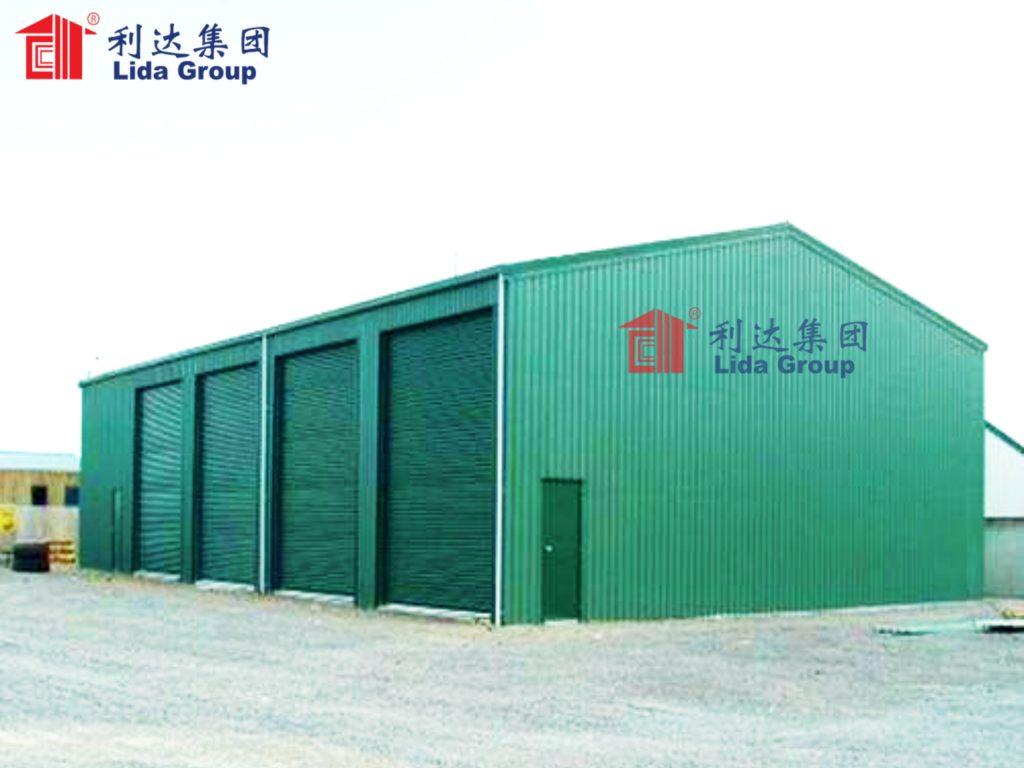
5. Real – World Case Studies: Lida Group’s Solutions in Action
To demonstrate the tangible impact of Lida Group’s climate – controlled steel farm houses and efficient steel frame buildings, below are three case studies from diverse regions and crop types. Each case highlights the challenges faced by farmers, the customized solution provided by Lida Group, and the measurable improvements in harvest storage.
5.1 Case Study 1: Grain Farmer in Canada (Wheat and Barley Storage)
A medium – scale grain farmer in Saskatchewan, Canada, faced two major challenges: extreme winter temperatures (as low as – 30°C) that caused grain to freeze and spoil, and limited storage space that forced them to sell excess harvest at a discount during peak season. The farmer needed a storage solution that could:
- Withstand harsh winter weather.
- Maintain a consistent temperature of 10–12°C for wheat and barley.
- Expand storage capacity by 50% to avoid forced sales.
Lida Group’s Solution:
Lida Group designed a 500 – square – meter clear – span steel storage facility with the following features:
- Climate – Control System: Heat pumps for winter heating, variable – speed compressors for summer cooling, and desiccant dehumidifiers to maintain 50–55% relative humidity.
- Steel Frame Design: S355JR steel frame with hot – dip galvanization for corrosion resistance, and a clear – span design (30 – meter span) to maximize storage space.
- Expansion Module: A modular section that could be added later to increase capacity by 200 square meters.
- Grain – Specific Features: Grain aeration fans, moisture sensors, and HEPA filters to prevent dust buildup.
Results:
- Temperature Control: The facility maintained a consistent 11°C even during winter temperatures of – 30°C, eliminating freeze damage entirely.
- Storage Capacity: The 500 – square – meter facility stored 250 tons of grain (50% more than the farmer’s previous wooden barn), allowing them to avoid forced sales. By storing grain until off – peak season (when prices were 15% higher), the farmer increased annual revenue by $37,500.
- Durability: After 4 years of operation, the steel frame showed no signs of corrosion or weather damage, and maintenance costs were just \(1,200 per year (70% less than the wooden barn’s \)4,000 annual maintenance).
The farmer commented: “Our old barn couldn’t handle Saskatchewan winters—grain would freeze solid, and we’d lose thousands. Lida Group’s steel facility keeps our grain at the perfect temperature, and we finally have enough space to wait for better prices. It’s been a game – changer for our business.”
5.2 Case Study 2: Fruit Grower in Spain (Apple and Pear Storage)
A commercial fruit grower in Catalonia, Spain, specialized in apples and pears but struggled with short storage life (2–3 months in traditional cold storage) and high losses due to ethylene buildup and mold. The grower needed a solution that could:
- Extend storage life to 6–8 months to sell fruit during the off – season.
- Reduce ethylene – related ripening and mold growth.
- Be customized to store different apple and pear varieties (each with slightly different temperature/humidity needs).
Lida Group’s Solution:
Lida Group delivered a 300 – square – meter climate – controlled steel farm house with:
- Dual – Zone Climate Control: The facility was divided into two zones—one for apples (0–2°C, 90% humidity) and one for pears (2–4°C, 85% humidity). Each zone had independent HVAC, humidification, and ethylene scrubbing systems.
- Ethylene Management: Activated carbon ethylene scrubbers in both zones, plus UV – C light systems in the apple zone (high ethylene producers).
- Mold Prevention: Desiccant dehumidifiers (to maintain precise humidity), HEPA filters (to reduce dust), and insect traps (to prevent fruit fly infestations).
- Steel Frame Advantages: Hot – dip galvanized steel frame to resist Spain’s humid Mediterranean climate, and a clear – span design to accommodate tall fruit storage racks (6 meters high).
Results:
- Extended Storage Life: Apple storage life increased to 8 months, and pear storage life to 6 months. The grower was able to sell fruit from the previous harvest during the next summer, when prices were 40% higher. This boosted annual revenue by $60,000.
- Loss Reduction: Mold losses dropped from 12% (traditional storage) to 1.5%, and ethylene – related ripening losses decreased from 8% to 0.5%.
- Variety Flexibility: The dual – zone design allowed the grower to store 5 different apple varieties and 3 pear varieties simultaneously, each in their ideal conditions. This increased their market diversity and reduced reliance on a single crop.
The grower noted: “Before, we had to sell all our apples and pears within 3 months, which meant competing with hundreds of other growers. Now, we can wait for the off – season, charge higher prices, and offer more varieties to our customers. Lida Group’s facility didn’t just store our fruit—it transformed our business model.”
5.3 Case Study 3: Vegetable Farmer in Kenya (Tomato and Onion Storage)
A small – scale vegetable farmer in Nakuru, Kenya, faced challenges with extreme heat (summer temperatures up to 35°C) that spoiled tomatoes within 1 week of harvest, and high humidity that caused onions to rot. The farmer also struggled with theft, as their open – air shed offered no security. They needed a solution that could:
- Keep tomatoes cool (12–15°C) to extend shelf life.
- Maintain low humidity (50–55%) for onion storage.
- Provide secure storage to prevent theft.
Lida Group’s Solution:
Lida Group provided a 150 – square – meter steel farm house with:
- Climate – Control System: Air conditioners with variable – speed compressors to maintain 12–15°C for tomatoes, and refrigerant dehumidifiers to keep humidity at 50–55% for onions.
- Security Features: Steel doors with deadbolt locks, perimeter fencing, and motion – activated security lights to deter theft.
- Modular Design: A compact modular layout that fit on the farmer’s small plot of land, with separate sections for tomatoes and onions.
- Affordable Energy: Solar panels installed on the roof to power the climate – control system, reducing reliance on Kenya’s unreliable grid electricity.
Results:
- Tomato Storage Life: The cooled storage extended tomato shelf life from 7 days to 28 days, allowing the farmer to transport tomatoes to Nairobi (2 hours away) and sell them at a 50% higher price than local markets.
- Onion Loss Reduction: Low humidity storage reduced onion rot from 20% to 3%, saving the farmer $1,200 per harvest.
- Security: No thefts were reported after installing the facility, compared to 2–3 thefts per year from the open – air shed.
- Energy Savings: Solar panels covered 80% of the facility’s energy needs, reducing electricity costs by $40 per month.
The farmer stated: “Before, I watched my tomatoes rot within a week and worried about thieves stealing my onions every night. Lida Group’s storage facility changed everything—I can sell tomatoes in Nairobi, my onions don’t rot, and I don’t have to stay up all night guarding my harvest. It’s given me peace of mind and a better income for my family.”
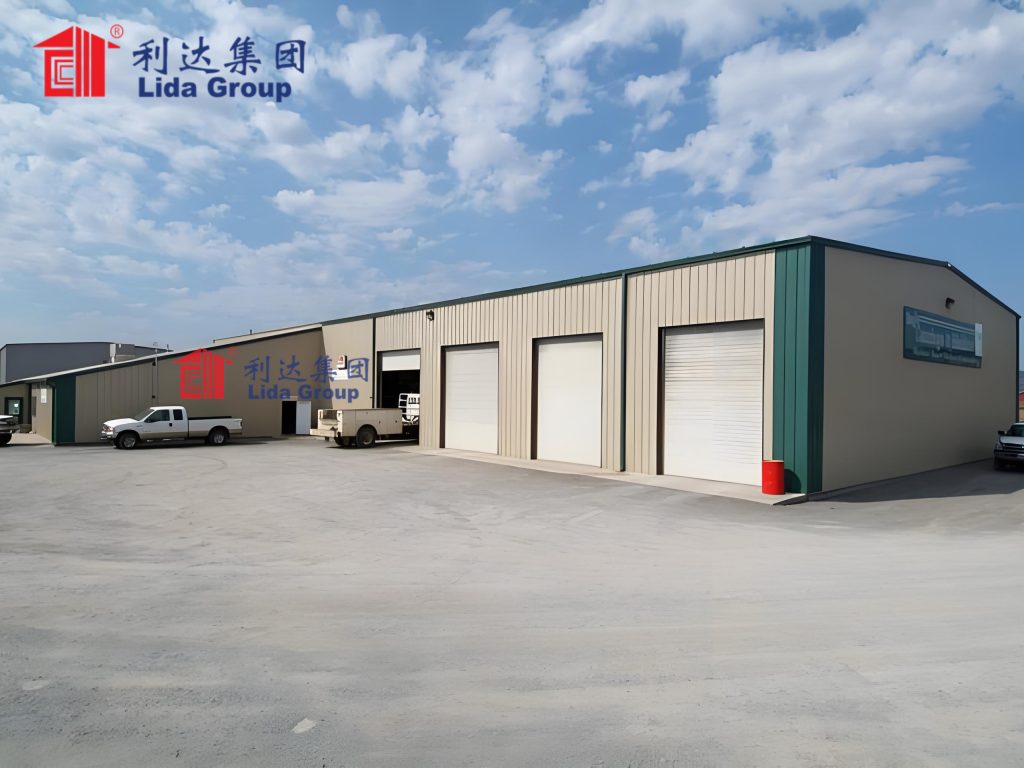
6. Conclusion
In conclusion, Lida Group’s climate – controlled steel farm house designs and efficient steel frame buildings represent a transformative solution for maximizing harvest storage. By addressing the core challenges of traditional storage—temperature extremes, humidity fluctuations, pest infestations, structural inefficiencies, and poor air quality—these innovations empower farmers to minimize post – harvest losses, extend crop shelf life, and increase their profitability.
The structural advantages of Lida Group’s steel frames—high – strength S355JR steel, hot – dip galvanization, clear – span design, and modular flexibility—provide a durable, space – efficient foundation for storage. These frames withstand extreme weather, maximize usable space (by 20–30% compared to traditional facilities), and adapt to changing harvest sizes and crop types, eliminating the need for costly, time – consuming expansions or multiple storage buildings.
Complementing the steel frame’s structural excellence, Lida Group’s advanced climate – control systems—precision temperature regulation, humidity management, pest prevention, and air quality control—create optimal storage environments for any crop. From keeping grains at 10–15°C to maintaining 80–85% humidity for strawberries, these systems reduce post – harvest losses from 10–50% (traditional storage) to less than 5% in many cases, while extending shelf life by 2–8 times.
The real – world case studies from Canada, Spain, and Kenya demonstrate the tangible impact of these solutions: farmers have increased revenue by 30–50%, eliminated freeze and mold damage, and secured their harvests from theft. Beyond financial gains, these facilities also contribute to food security by reducing waste and allowing farmers to distribute crops to distant markets, helping to feed growing global populations.
As climate change continues to bring unpredictable weather and extreme conditions, Lida Group’s solutions offer a resilient, sustainable path forward for agricultural storage. By combining steel’s durability with cutting – edge climate technology, the company is not just building storage facilities—they are building a future where farmers can thrive, even in the face of global challenges.
For farmers seeking to protect their harvests, maximize their returns, and adapt to a changing world, Lida Group’s climate – controlled steel farm houses and efficient steel frame buildings are the clear choice. They represent the future of harvest storage—one where innovation, durability, and sustainability work together to secure the livelihoods of farmers and the food supply of our planet.

Related news
-
The Future of On-Site Accommodation: Smart Technology in Lida Group's Prefab Worker's Dormitory and Mobile Units
2025-09-08 17:51:29
-
Lida Group Revolutionizes Agricultural Storage with High-Quality Steel Farm Houses Using Advanced Steel Frame Building Techniques
2025-09-10 10:36:37
-
Cost-Effective Workforce Housing: Lida Group's Temporary Sandwich Panel House Cuts Construction Time and Operational Budgets
2025-09-05 17:33:02
contact us
- Tel: +86-532-88966982
- Whatsapp: +86-13793209022
- E-mail: sales@lidajituan.com


